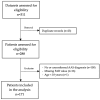Fibrinogen-to-Albumin Ratio as Predictor of Mortality in Acute Aortic Syndromes
- PMID: 40095623
- PMCID: PMC11900113
- DOI: 10.3390/jcm14051669
Fibrinogen-to-Albumin Ratio as Predictor of Mortality in Acute Aortic Syndromes
Abstract
Background: Acute aortic syndrome (AAS) is a life-threatening condition characterized by a high mortality, yet reliable prognostic biomarkers are still lacking. The fibrinogen-to-albumin ratio (FAR) has recently gained attention in cardiovascular research but has not been explored in the context of AAS. This study assessed the association between the FAR and 30-day mortality in AAS patients who presented to the emergency department. Methods: We included all AAS patients aged 18 years and older who presented to the emergency department between 2013 and 2021. The outcome measured was 30-day all-cause mortality. Cox regression analysis assessed the relationship between the FAR and the outcome. Results: A total of 171 patients (mean age 67, SD 13.7; 33% female) were included, with 68 (40%) dying within 30 days of admission. Non-survivors had a significantly lower FAR (mean 8.9, SD 4.97) than survivors (mean 10.8, SD 5.44, p = 0.02). FAR was significantly associated with 30-day mortality (crude HR 0.935, 95% CI 0.88-0.99, p = 0.02). This association remained significant after adjusting for age, sex, cardiopulmonary resuscitation, catecholamine administration, bleeding on admission, and type of AAS (adjusted HR 0.92, 95% CI 0.87-0.98, p = 0.01). Conclusions: FAR was independently associated with 30-day mortality in AAS patients who presented to the emergency department. Given its simplicity and cost-effectiveness, it could be a valuable biomarker, especially in resource-limited settings, to improve risk assessment and optimize resource allocation in AAS.
Keywords: acute aortic syndrome; biomarkers; cardiovascular disease; emergency medicine.
Conflict of interest statement
The authors declare no conflicts of interest.
Figures
Similar articles
-
[Risk factors for adverse prognosis in acute aortic syndrome: a single-center retrospective cohort study].Zhonghua Xin Xue Guan Bing Za Zhi. 2025 Feb 24;53(2):136-142. doi: 10.3760/cma.j.cn112148-20240903-00507. Zhonghua Xin Xue Guan Bing Za Zhi. 2025. PMID: 39965848 Chinese.
-
Plasma Lactate Dehydrogenase Levels Predict Mortality in Acute Aortic Syndromes: A Diagnostic Accuracy and Observational Outcome Study.Medicine (Baltimore). 2016 Feb;95(6):e2776. doi: 10.1097/MD.0000000000002776. Medicine (Baltimore). 2016. PMID: 26871831 Free PMC article.
-
Ethnic differences in incidence and outcomes of acute aortic syndromes in the Midland region of New Zealand.J Vasc Surg. 2022 Feb;75(2):455-463.e2. doi: 10.1016/j.jvs.2021.08.066. Epub 2021 Sep 24. J Vasc Surg. 2022. PMID: 34506891
-
Association of fibrinogen-to-albumin ratio with all-cause and cardiovascular mortality in patients on dialysis with acute coronary syndrome.Postgrad Med J. 2025 Feb 8:qgaf015. doi: 10.1093/postmj/qgaf015. Online ahead of print. Postgrad Med J. 2025. PMID: 39921677
-
Prognostic value of novel serum biomarkers, including C-reactive protein to albumin ratio and fibrinogen to albumin ratio, in COVID-19 disease: A meta-analysis.Rev Med Virol. 2022 Nov;32(6):e2390. doi: 10.1002/rmv.2390. Epub 2022 Aug 27. Rev Med Virol. 2022. PMID: 36029484 Free PMC article. Review.
References
LinkOut - more resources
Full Text Sources



